



Rolling parallel rules were used for both drafting and navigational purposes. Six inch bar type rules were frequently included in sets of drawing instruments. Larger ones were used for both purposes. Rolling parallels used for drawing often had edge scales in ivory or, later, celluloid. Captain Fields Improved parallel rules, in both bar and rolling forms were for navigation.
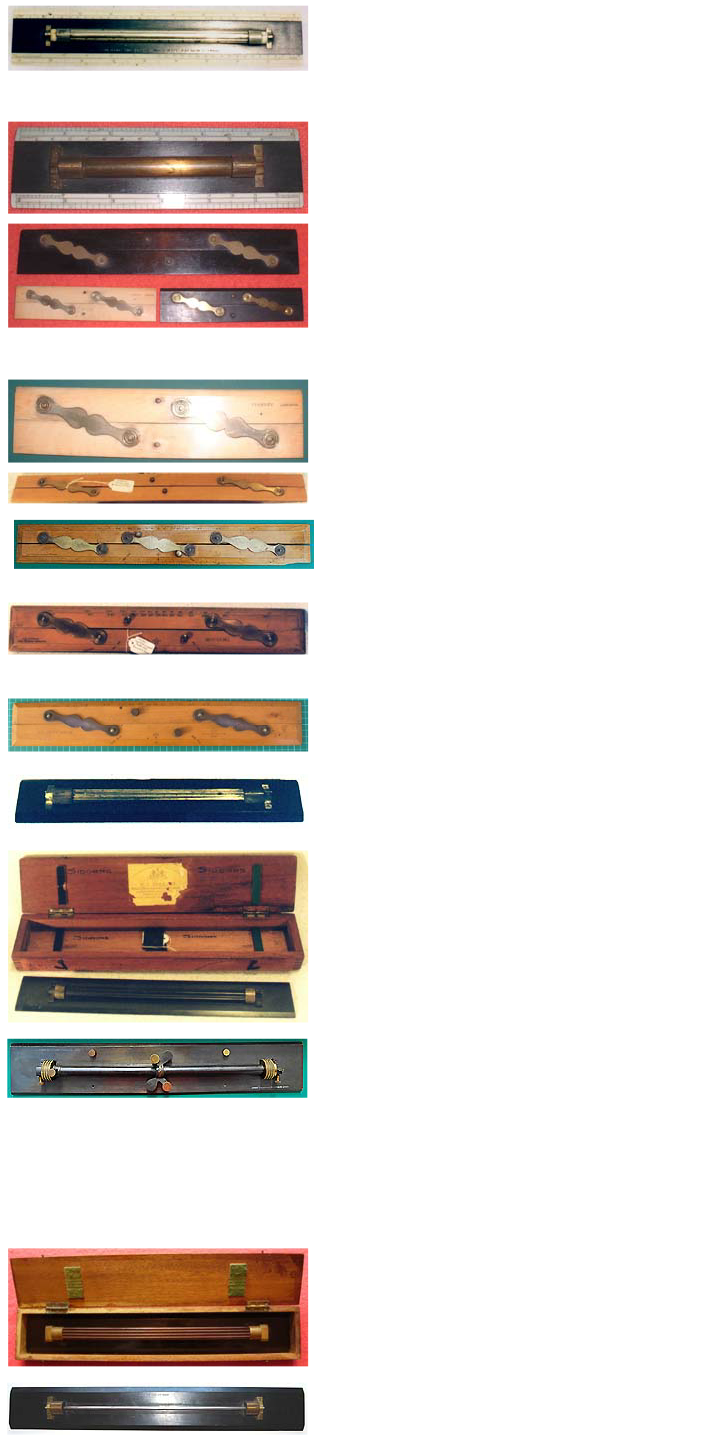

A nickel-silver, ebony and ivory, nine inch, rolling parallel rule by C W Dixey, instrument maker to Queen Victoria. This fine example dates from between 1839 and 1862 when Dixey was working at his 3 New Bond Street, address which is imprinted on the rule.

A six inch, ebony, ivory and brass rolling parallel rule from the nineteenth century. Being of the six inch size it probably originated in a magazine case of drawing instruments.
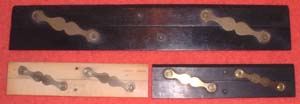
A selection of parallel rules in ebony and ivory. The six inch ivory one is by Stanley and the six inch ebony one is by Elliott Bros. The twelve inch rule is unsigned. Mid nineteenth century to c1900. It is very difficult to date ebony parallel rules that are unsigned because the same pattern was made for over 100 years. The two smaller ones come from boxed sets of instruments which are c1900.

The six inch Stanley ivory parallel rule again.
An eighteen inch boxwood parallel rule.

An eighteen inch, Captain Field's Improved parallel rule in boxwood. Probably twentieth century, maker unknown. These rules were used for navigation of both ships and aircraft.
This 18” Captain Field’s Improved parallel rule was made by Dargue Bros for the Air Ministry in 1938. Similar ones were made in 1944 by Aston & Mander.

A twelve inch, ebony and brass, rolling parallel rule signed "W Newman & Co Limd, Calcutta". They were presumably the retailers.
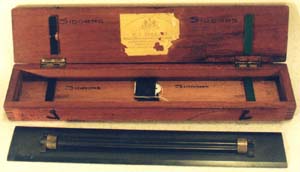
This heavy, black japanned brass, fifteen inch, parallel rule was probably used for navigation. It is housed in a mahogany box with W F Stanley's trade card inside the lid and is late nineteenth century.

Stockman & Doyles’ Spacing Parallel Rule sold by J Short, 2 Gladstone St, Southwark, London. By the left hand wheel is a thumbscrew that is used to lock the sleeve to the spindle when the spacing mechanism, seen in the centre, is in use. The mechanism rocks the sleeve and hence rotates the spindle to provide the space between the parallel lines. The spacing distance can be set using the two thumb screws by the rocking levers. A scale on the right hand wheel enables the spacing distance to be accurately set. The body of the 15” instrument is blackened brass. It has a mahogany box.
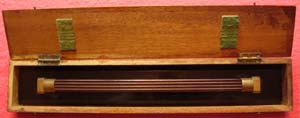
An Ebonite and Tufnol, eighteen inch parallel rule in mahogany case.


An unusual, boxwood parallel rule by Coombes of Devonport, 15 inches long. The upper portion can be used as a protractor.

Hezzanith Hills patent no. 15455 boxwood 15 inch Fields parallel rule. The unusual links give a much wider range of movement than usual and the upper and lower arms remain in line. Hezzanith was a trade mark of Heath & Co, later part of W F Stanley. Early 20th century.

Ebony and brass 12” sectioning parallel. The line separation can be adjusted by moving the brass piece in the centre in and out.

Eyre & Spottiswoode “Hidden Bar Parallell. It is 12” long and made from boxwood with brass links. Patented in 1887, patent no. GB1887/10744. There are scales on three edges.

Mahogany and brass rolling parallel rule with indexing system for spacing lines 2, 3, 4, 5, 6, 7, 8, 10, and 12 mm apart. Marked Brevete SGDG (i.e. patented in France) and No. 2 with fish in an ellipse trade mark. 300mm (12 in) long.


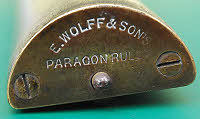
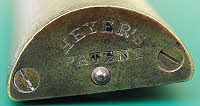
E Wolff & Sons “Paragon Rule”, Heyer’s patent. Fifteen inch long rolling parallel rule of wood and brass construction. The wood shroud appears to be black painted mahogany or possibly red cedar and the wood roller is ebonised. Better than the plain round rule but only just! Possibly late 19th century - I haven’t found the patent. E Wolff & Sons were pencil makers founded in 1796. In 1920 they amalgamated with B S Cohen to form the Royal Sovereign Pencil Co.

The Maclean 360º Parallel Rule, Sole Manufacturers The London Name Plate Mfg Co Ltd, Patent 543001. It is made of transparent plastic and chrome plated metal. The roller is encased. The patent date is May 1941. There is a locking screw at the right hand end of the enclosure. It has a cardboard box.

Astonmanda B8262 1944 15” parallel rule, Bakelite and brass.
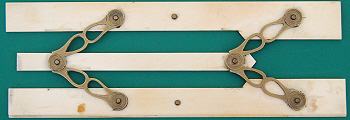
Three bar parallel rule from a shagreen etui cased set of instruments by A Abraham, early 19th century

Blundell Harling 0651.03 300mm acrylic Capt. Field’s pattern parallel rule, late 20th century
| Early Sets |
| Traditional Sets |
| Later Sets |
| Major Makers |
| Instruments |
| Miscellanea |
| W F Stanley |
| A G Thornton |
| W H Harling |
| Elliott Bros |
| J Halden |
| Riefler |
| E O Richter |
| Kern, Aarau |
| Keuffel & Esser |
| Compasses |
| Pocket compasses |
| Beam compasses |
| Dividers |
| Proportional dividers |
| Pens |
| Pencils |
| Rules |
| Protractors |
| Squares |
| Parallels |
| Pantographs |
| Sectors |
| Planimeters |
| Map Measurers |
| Miscellaneous |
| Materials Used |
| Who made them |
| Who made these |
| Addiator |
| Addimult |
| Other German |
| USA |
| Miscellaneous |
| Microscopes |
| Barometers |
| Hydrometers & Scales |
| Pedometers |
| Surveying Instruments |
| Other instruments |
| Workshop Measuring Tools |
| Catalogues & Brochures |
| Levels & Theodolites |
| Compasses & Clinometers |
| Miscellaneous surveying |
| Micrometers & Verniers |
| Engineering rules and gauges |
| Wood rules & calipers |
| Dial gauges & miscellaneous |
